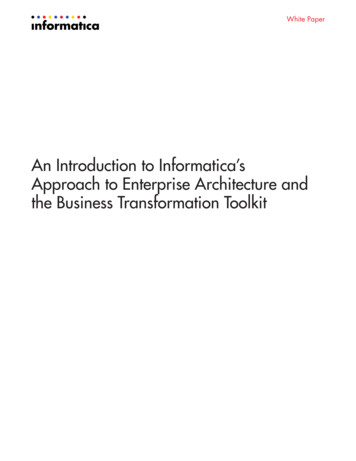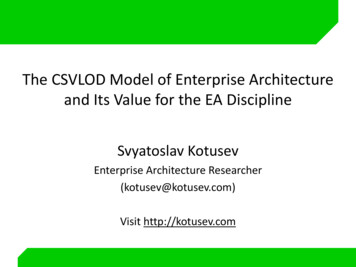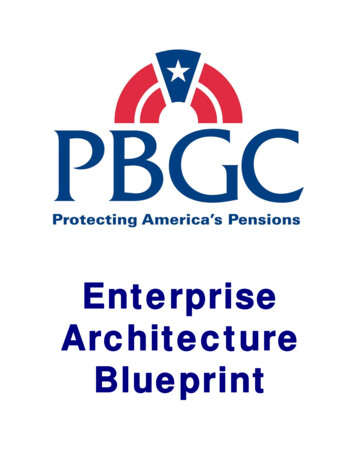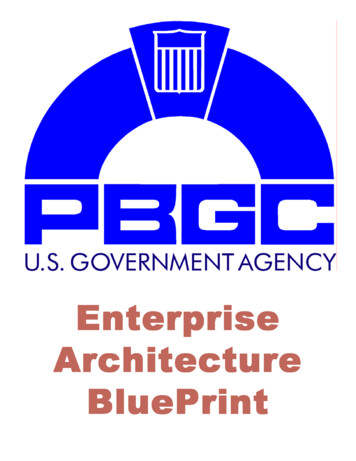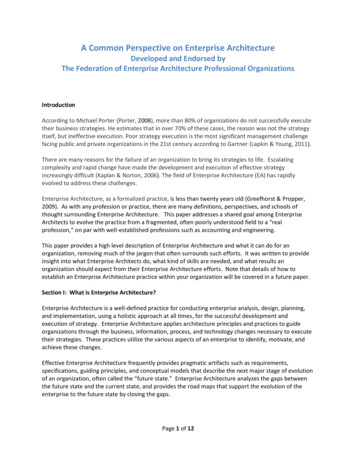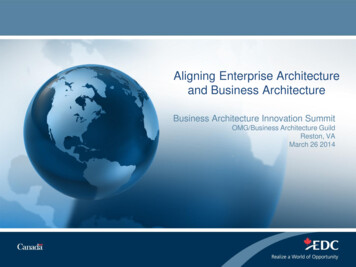
Transcription
ENTERPRISE ARCHITECTUser Guide SeriesGuide to EnterpriseArchitectureAuthor: Sparx Systems &Stephen MaguireDate: 2022-06-07Version: 16.0CREATED WITH
Table of ContentsGuide to Enterprise ArchitectureIntroductionEnterprise Architecture OverviewWhat is Enterprise ArchitectureContext for Enterprise ArchitectureLevels of ArchitectureTypes of ArchitectureScope of ArchitectureCharacteristics of Good ArchitectureLists, Diagrams and MatricesMeet the Enterprise Architecture ToolsActivity DiagramAuditingBalanced ScorecardBusiness Process DiagramCalendarClass DiagramComponent DiagramDashboard DiagramsDecision Tree DiagramDeployment DiagramDocumentationGap Analysis 5108
Heat MapImport and Export SpreadsheetsOrganizational Chart DiagramPatternsRelationship MatrixRequirements DiagramRoadmap DiagramSpecification ManagerStrategy MapLibraryTime Aware ModelingTraceability WindowValue ChainUses of an Enterprise ArchitectureMergers and AcquisitionsCorporate DivestitureArchitecture OversightBusiness and Systems ImprovementCommunicationEnterprise TransitionsImplementation GuidePortfolio ManagementArchitecture Program SetupManagement StructureArchitecture FrameworkArchitecture ProcessArchitecture 62164165167168170172174176177178187189195
Tool SetupArchitecture PrinciplesManaging an Enterprise ArchitectureArchitecture GovernanceGovernance ProcessArchitecture Steering CommitteeArchitecture Review BoardGovernance RegisterDeveloping an Enterprise ArchitectureArchitecturesBusiness ArchitectureStrategic PlansMission and VisionDriversGoals and ObjectivesCapabilitiesBusiness ProcessesInformation ArchitectureConceptual Information ModelLogical Data ModelSchemas and MessagesPhysical Data ModelApplication ArchitectureApplication Lists Diagrams and MatricesApplication CommunicationInterface ListsCapabilities and 0256259262265269271274276278281283288291293
Business Processes and ApplicationsTechnology ArchitectureApplication Platform ServicesTechnical Reference ModelInfrastructure FacilitiesStakeholder ModelingRequirements ModelingDocumenting an Enterprise ArchitectureArchitecture DescriptionArchitecture Requirements SpecificationArchitecture VisionCommunication PlanCompliance AssessmentProject GlossaryEnterprise Architecture TechniquesArchitecture GovernanceArchitecture Requirements ManagementArchitecture PartitioningApplication Portfolio ManagementBalanced ScorecardBaselines and VersioningBusiness Goals and Objectives ModelingBusiness ScenariosCapability Based PlanningCapability ModelingCompliance AssessmentConcept 321322327333338344348352357363366372373
Data ModelingDriver ModelingFunctional DecompositionGap AnalysisGlossaryInterface AnalysisMind MappingOrganizational ModelingPattern AnalysisPrinciples ManagementProcess AnalysisProcess ModelingReviewsRisk Analysis and ManagementRoadmapsStakeholder ManagementStandards ModelingTechnical Reference ModelTime Aware ModelingUse Cases and ScenariosViews and ViewpointsWorkshopsAdditional Enterprise Architecture ToolsAuto-Names and CountersBaseline ToolBoundaryDocument 433438451455463469474483492493496499503
DiscussionsGlossaryImage ManagerList ViewMind Mapping DiagramModel MailModel ViewsModel SearchPackage BrowserPan and ZoomBrowser WindowRequirements ChecklistRequirement PropertiesRisk TaxonomySecurityStereotypingTagged ValuesVisual FiltersWorking 58562565569
Guide to Enterprise Architecture7 June, 2022Guide to Enterprise ArchitectureEnterprise Architecture has emerged as a discipline that canhelp steer the 'ship' of the enterprise through both quiet andturbulent waters, charting a course from its current locationto a future location in a safe and streamlined way. Thediscipline has become more prevalent in recent years, butthe precepts go back almost to the beginning of what isoften termed the information age. An enterprise is one of themost complex man-made systems and is composed ofhuman, political, social, software, hardware and technologycomponents. In an enterprise of any appreciable size, it isimpossible for a single person to understand the way theparts all work together, let alone understand its position inrelation to the system of other organizations that form itsenvironment, or to determine how it can evolve.Enterprise Architecture can be used to create visualizationsof the enterprise at different levels of abstractions and tocreate Roadmaps that show how the enterprise can betransitioned from its baseline (current) state to a target(future) state.(c) Sparx Systems 2022Page 9 of 573
Guide to Enterprise Architecture7 June, 2022Enterprise Architect is a multi-featured platform that can beused to define the strategic context for an EnterpriseArchitecture, the Enterprise Architecture itself, and theImplementation initiatives that realize the designs and thatfinally deliver the business value. It can serve both as thearchitectural repository and as a tool for managing theprocess by which architectures are created and maintained,including an architectural requirements managementplatform. Rich visualization capabilities allow models to betransformed and presented in a variety of compelling waysthat will delight stakeholders, from the executive levelthrough to the implementation teams.(c) Sparx Systems 2022Page 10 of 573
Guide to Enterprise Architecture7 June, 2022The tool can be used to define Strategic, Tactical andSolution Architectures and to provide compelling views fora wide range of stakeholders, from senior executivesthrough to implementation partners. Business, Information,Application and Technology architectures can be createdand managed, and baseline and target architectures defined,allowing transitions to be visualized.(c) Sparx Systems 2022Page 11 of 573
Guide to Enterprise Architecture(c) Sparx Systems 20227 June, 2022Page 12 of 573
Guide to Enterprise Architecture7 June, 2022IntroductionThe discipline of Enterprise Architecture dates back to themid-eighties when John Zachman recognized the need tomanage the complexity of distributed technology systems.Enterprise Architecture has since become one of the mostimportant disciplines in the business and informationtechnology professions and has become increasinglyrelevant in an era dominated by digital disruption. Whendone well, Enterprise Architecture can be used to guide anorganization through the complex business and digitallandscape that currently confronts business and technologyleaders.Enterprise Architect has become the tool of choice for manyleaders in the industry because of its flexible, extensible andpragmatic approach to modeling complex systems. As aplatform, Enterprise Architect offers a unique capability insupporting the integration of strategic, business andtechnology models, from motivation models down to theimplementation of systems. The tool allows the architect tocreate Strategic models (including diagrams such as theBalanced Scorecard), Capability models, Tactical modelssuch as Gap analysis, and Roadmaps and Operationalmodels, appealing to stakeholders from the seniorexecutives through to line managers and solution andimplementation teams.(c) Sparx Systems 2022Page 13 of 573
Guide to Enterprise Architecture7 June, 2022How it will help youReaders will typically come to the topic of EnterpriseArchitecture with some existing knowledge or experience,even if it is something that has been learnt in lectures or byon the job training, or perhaps by using a different tool.(c) Sparx Systems 2022Page 14 of 573
Guide to Enterprise Architecture7 June, 2022Readers will benefit by understanding the product's featuresand the tools that are available to develop and manageEnterprise Architectures in Enterprise Architect, and thiswill enable them to be more productive as an individual andas a member of a team.Who will benefitAnyone involved in the development or management ofarchitectures, whether at a strategic level, a business valuelevel or a technology level will benefit from reading thisinformation. This includes a wide range of roles includingStrategic Thinkers, Senior Management, Business,Information, Application and Technology Architects,Solution Architects and Implementation teams whose workand decisions will ultimately be guided by the architectures.What you will learnThis topic will teach you how to use the versatile features ofEnterprise Architect to develop and manage EnterpriseArchitectures, to create documentation and to workcollaboratively as a member of a team using a formal orinformal architecture framework. You will learn what toolsare available, how to use them and which tools should beused to perform a particular technique. For example,(c) Sparx Systems 2022Page 15 of 573
Guide to Enterprise Architecture7 June, 2022regardless of the process or framework that is adopted, atsome point Architectural Partitioning will need to beperformed; this topic will describe the technique and how tobest achieve it using the tools and facilities you have at yourfingertips using Enterprise Architect.Overview of the DocumentationThis table provides a list and a description of the subjectsthat are included in this work, giving an overview of thematerial.Enterprise This topic gives a high level view ofArchitecture Enterprise Architecture, describing whatOverview it is and the levels, types and styles ofarchitecture. It describes some of thecharacteristics of good architecture andthe outputs and content of an architectureprocess such as catalogs, matrices anddiagrams. It also puts EnterpriseArchitecture into the context of otherdisciplines, from the strategic levelthrough to the operational level, includingSolution Architectures.Meet the This topic lists the key tools that are usedEnterprise in Enterprise Architecture, including aArchitecture picture of the tool in action, where to find(c) Sparx Systems 2022Page 16 of 573
Guide to Enterprise Architecture7 June, 2022Tools the tool, how to use it and how to becomeproficient in using the tool. There aremany additional tools that will be useful,which are described in the last topicentitled Additional EnterpriseArchitecture Tools.Uses of an This topic describes how an EnterpriseEnterprise Architecture can be utilized, who will getArchitecture benefit and how that benefit can berealized. This includes the use of anarchitecture as a communication tool andstrategic guide for senior management, oras a guide for solution architects andimplementation teams and for thepurposes of the oversight ofimplementation projects. It will alsodescribe the use of an architecture forportfolio management, business systemsimprovement and for analyzing, definingand documenting enterprise transitions,including Acquisitions and Mergers.Architecture Many architects suffer from the blankPractice canvas syndrome, because much of theSetup literature describes how to developarchitectures but is silent about setting upan architecture practice. This topic willguide you in using Enterprise Architect toset up an Architecture Practice, including(c) Sparx Systems 2022Page 17 of 573
Guide to Enterprise Architecture7 June, 2022Framework options and how to set up thetool to support the practice. This includesrepository structure, principles, teamcollaboration, documentation generationusing templates, meta-model definition,governance structures, language supportand more. It loosely aligns with thePreliminary phase of The Open GroupArchitecture Framework ArchitectureDevelopment Method (TOGAF ADM).Planning an An architecture is a project and needs toEnterprise be planned. This topic explains how to setArchitecture up an architecture project, including thedefinition of the scope, constraints andthe desired enterprise outcomes,including problems or opportunities thatthe architecture is addressing. It describeshow the architecture aligns withenterprise strategy and how it relates tosolution architectures that will ultimatelyimplement the architecture in practice. Itloosely aligns with the Vision phase ofthe TOGAF ADM.ManaginganEnterpriseArchitecture(c) Sparx Systems 2022The management of an architectureinvolves the set up, monitoring andcontrol of the architecture project from itsinception through to its delivery. Teamcapabilities, tool usage, the quality ofPage 18 of 573
Guide to Enterprise Architecture7 June, 2022architectural artifacts, communicationmechanisms, governance structures andstakeholder management are all describedin this topic. The use of EnterpriseArchitect as a tool for the management ofan architecture will be fully described his topic describes how EnterpriseArchitect can be used to create andmaintain an Enterprise Architecture. It isthe centerpiece of the discussion andarticulates how the architecture is used todescribe the way the organization willtransition from a baseline to a target state,resulting in the attainment of businessgoals and objectives and new oraugmented capabilities.Documenting anEnterpriseArchitectureThis topic describes the multi-featureddocumentation features of EnterpriseArchitect, allowing Architects, Analysts,Managers and others to generate a rangeof documentation, from ad-hoc reports topublication of quality documents directlyout of the architecture repository. It willdescribe creating organization-specificdocumentation using a sophisticated andflexible template system for generatingdocuments into a range of formats,(c) Sparx Systems 2022Page 19 of 573
Guide to Enterprise Architecture7 June, 2022including PDF, DOCX and his topic describes EnterpriseArchitect's support for frameworks,languages and standards. This consists ofa wide range of frameworks, includingThe Open Group ArchitectureFramework (TOGAF), the FederalEnterprise Architecture Framework(FEAF) and the Zachman Framework.Languages such as the Unified ModelingLanguage (UML), ArchiMate andBusiness Process Model and Notation(BPMN) are described, as are standardssuch as the National InformationExchange Model (NIEM).Enterprise This topic describes the importantArchitecture techniques that are used by ArchitectsTechniques when working with architectures, fromthe setup phase through planning,managing, developing and documentingarchitectures. Each technique isdescribed, with a list of the toolsavailable in Enterprise Architect that canbe used to perform the technique,explaining the use of the tool in thecontext of the technique.Additional This topic lists a series of additional tools(c) Sparx Systems 2022Page 20 of 573
Guide to Enterprise Architecture7 June, 2022Enterprise that can be used for EnterpriseArchitecture Architecture, including a picture of theTools tool in action, where to find the tool, howto use it and how to become proficient inusing the tool. There are a number of keytools that are considered to be mostimportant for enterprise architecture,which are described in the Meet theEnterprise Architecture Tools section.(c) Sparx Systems 2022Page 21 of 573
Guide to Enterprise Architecture7 June, 2022Enterprise Architecture OverviewEnterprise Architecture has emerged as a critical disciplineto ensure that an enterprise and the organizations itcomprises have an understanding of the significant elementsfrom which it is made, from strategic goals through to thebusiness and information technology components that assistin achieving those goals. The discipline also allowsenterprises to create architectures that will transition fromwhere they are to where they need to be. Now more thanever in this age of digital disruption, when organizations canno longer rely on length of tenure in a field or being biggerthan their competition as a safeguard against competitiveforces, Enterprise Architecture as a discipline is vital.The profession of Enterprise Architect is rarely taught as aseparate degree course at tertiary institutions, and it alsosuffers under the proliferation of large, conflicting and attimes burdensome frameworks and a lack of tool support.This has led to architecture practitioners finding it difficultto articulate or demonstrate the value of their 'profession'.This section addresses the questions:· What is Enterprise Architecture?· Where does it fit into the context of other disciplines?· What are the characteristics of good architecture?The section also discusses the levels, types and styles ofarchitecture that exist, and describes the notationalmechanisms that are at an architect's disposal.(c) Sparx Systems 2022Page 22 of 573
Guide to Enterprise Architecture7 June, 2022Enterprise Architect's pragmatic approach to modeling, andthe extensive set of facilities available to the architect andothers, make it a versatile tool both as an architecturerepository and as a platform for creating, managing anddisseminating architectural work.(c) Sparx Systems 2022Page 23 of 573
Guide to Enterprise Architecture7 June, 2022What is Enterprise ArchitectureThere is still robust and lasting debate about whatarchitecture is in the context of an enterprise, which makesit difficult to provide a universally accepted definition of theterm 'Enterprise Architecture'. This is not helped by the factthat there is not a standard curriculum for architecture or anyof its flavors in our tertiary institutions, nor do manyinstitutions teach architecture at a graduate or post graduatelevel. People come to the discipline from a wide range ofbackgrounds and produce an equally wide range of workproducts that come under the general heading ofarchitecture.The ISO/IEC 42010 standard defines architecture as:'The fundamental organization of a system, embodied in itscomponents, their relationships to each other and theenvironment, and the principles governing its design andevolution'.In this context the system that is under discussion is theenterprise. Using this definition it is important to separatethe fact that there is a description of the architecture (oftencalled an architecture) and the architecture that has beenbuilt. Enterprise Architect is used to define or document thedescription of the architecture and therefore provides arepresentation or way of visualizing a planned or builtarchitecture. The comprehensive facilities available inEnterprise Architect have been designed by practitionersand are continually improved to create a formidable tool that(c) Sparx Systems 2022Page 24 of 573
Guide to Enterprise Architecture7 June, 2022is both robust and flexible, and that makes creating andmanaging Enterprise Architectures easy, regardless of thedefinition that is applied.(c) Sparx Systems 2022Page 25 of 573
Guide to Enterprise Architecture7 June, 2022Context for Enterprise ArchitectureAn Enterprise Architecture Program is best viewed as anoperational unit of the business, and as such it has a context.The program must provide value to the business; it does thisby ensuring that architectural effort is aligned with thestrategic plans of the organization and that theimplementation initiatives are carried out in such a way thathonors the enterprise architecture.Enterprise Architect has a number of convenient features tomodel and visualize the alignment of the architectures andthe strategic plans. These visualizations can be used whenassessing which Information Technology initiatives arecontributing to the strategic business goals and objectives.Enterprise Architect has a number of useful facilities forguiding the implementation projects and assessing theirlevel of compliance, including the Model Library facilityand the definition of how principles are applied in thecontext of the solution architectures.(c) Sparx Systems 2022Page 26 of 573
Guide to Enterprise Architecture7 June, 2022Strategic ContextThe Business Architecture must be related back to theStrategic Plans to ensure that all the other architecturedomains that describe the architecture in more detail areultimately going to benefit the enterprise and deliver value.Business Architects typically gather information from thecompany strategists and should be privy to the high-leveldiscussions and decisions about the future plans for theenterprise and its organizations.Enterprise Architect has a number of tools that help toensure that the architecture's alignment to the strategic planscan be visualized, and that the drivers forming part of theBusiness Architecture are related back to elements of the(c) Sparx Systems 2022Page 27 of 573
Guide to Enterprise Architecture7 June, 2022plan. The business plan will typically reside in a corporaterepository but a hyperlink can be created from an Artifactwithin Enterprise Architect that will launch the StrategicPlan or other documentation. Elements of the BusinessArchitecture can be related to the Artifact that acts as asurrogate for the external plan.Implementation ContextThe purpose of the architecture is to ensure that initiativesand projects deliver the business value and benefits thathave been described in the architectural models, so(c) Sparx Systems 2022Page 28 of 573
Guide to Enterprise Architecture7 June, 2022monitoring the compliance of the implementation projects iscritical to the success of the architectures and ultimately thearchitectural program. Implementation Governance is a keypart of the architectural process and needs to be formallymanaged to ensure that the architecture acts as a guide forthe implementation teams, but also to ensure that thearchitecture is clearly understood and followed. TheImplementation initiatives are ultimately what transforms anorganization from a baseline (current) state to a target(future) state, and ensuring that these initiatives comply withthe principles and the designs is critical to the success of theprogram.Enterprise Architect has a number of tools to assist with thegovernance of Implementation initiatives, including theFormal Review facility that can be used to conduct one-offor repeating reviews of projects, ensuring that their level ofcompliance can be determined. The fact that Strategic,Tactical and Solution Architectures and implementationprojects can be managed in the same tool makes thegovernance process more streamlined. Even if the EnterpriseArchitecture and the implementation projects are located inseparate repositories, content can be imported into thearchitecture repository for the purpose of making theassessment. Examples of how the principles are applied inthe context of each initiative can be modeled using Instancesof Principles, providing a useful guidance forimplementation teams.(c) Sparx Systems 2022Page 29 of 573
Guide to Enterprise Architecture7 June, 2022Levels of ArchitectureAn Enterprise has a complex and typically hierarchicalstructure, and you will need to create architectures atdiscrete levels of this structure. This hierarchy ofarchitectures is analogous to the hierarchies of goals andcapabilities, and intuitively aligns with Strategic, Programand Project level divisions. In a small organization it mightbe possible to create a single architecture that covers theStrategic level and the Project or Capability levels, but in anenterprise of any appreciable size at least three separatelevels are typically needed. The naming of the levels hasbeen influenced by The Open Group ArchitectureFramework (TOGAF).· Strategic - Long term in the range of 3 - 5 years· Tactical - Mid term in the range of 1 - 2 years· Solution - Short term in the range of 6 - 12 monthsThe different levels of architecture will address differentlevels of concerns and have different audiences. Thearchitecture framework and the repository must assist inensuring these architectures are leveled and synchronized sothat they form a cohesive and balanced view of the entireenterprise.Enterprise Architect has a number of useful features thatwill assist the architecture program to partition and maintainthese levels of the architecture and their inter-relationships.(c) Sparx Systems 2022Page 30 of 573
Guide to Enterprise Architecture7 June, 2022StrategicStrategic architectures describe strategic plans andinitiatives and typically run for years rather than months. AStrategic architecture will provide a long-range plan that istypically a view of the future over a three to five yearperiod; this period can be longer for industries or enterprisesthat are not affected by dynamic and disruptiveenvironments. The Strategic architectures must support (oralign with) the enterprise's strategic goals, and Tactical andSolution architectures must help achieve the Strategicarchitecture or run the risk of not being funded.Enterprise Architect can be used to define and manage(c) Sparx Systems 2022Page 31 of 573
Guide to Enterprise Architecture7 June, 2022Strategic-level architectures, and can also help to ensure thatTactical and Solution architectures are aligned to support thestrategic direction. The Strategic Modeling technology has anumber of tools that can be utilized, such as the BalancedScorecard diagram that can help to identify goals related toInformation Technology. There are a number of tools,including the Relationship Matrix, diagrams and theTraceability window, that can be used to show therelationships between elements of the Business,Information, Application and Technology architectures andto ensure that they all demonstrably contribute to theachievement of the strategic goals.(c) Sparx Systems 2022Page 32 of 573
Guide to Enterprise Architecture7 June, 2022TacticalTactical architectures describe mid-range plans that help topartition the Strategic-level architectures into manageablegroups. They typically could run for a number of years andrepresent a portfolio or program-level plan of how toachieve the goals expressed in the strategic architectures(c) Sparx Systems 2022Page 33 of 573
Guide to Enterprise Architecture7 June, 2022they relate to. They act as a framework for organizingsolution-level initiatives and ensuring that capabilities aredeveloped that ultimately create business value.Enterprise Architect has tools to support the Tactical-levelarchitectures and to ensure that the partitioning of theStrategic-level architectures - and in turn the partitioning toSolution-level architectures - can be visualized. Roadmapdiagrams can be used at all levels of the Tacticalarchitecture, including Business, Information, Applicationand Technology architectures, showing the time sequencingof the initiatives at a portfolio or program level.Solution(c) Sparx Systems 2022Page 34 of 573
Guide to Enterprise Architecture7 June, 2022Solution architectures describe specific project- orcapability-level initiatives that can typically be completed inmonths rather than years. From a business perspective theyare usually focused on a particular problem or opportunity.Similarly, from a technical level they usually involve a slicethrough Information, Application and Technology areas, butmight in some circumstances require a number of these to beaddressed.Enterprise Architect has a rich set of tools that can assist atthe Solution architecture level, from defining the businessgoals and objectives and relating these to information andapplication components, to the technology devices thatunderpin the applications. Business Architecture can bedefined and managed using stereotypes and profiles tocreate representations of the Business Drivers, Goals andObjectives, and these can be demonstrated to stakeholdersusing diagrams, matrices and documentation publishedautomatically from the models. Tools such as the SchemaComposer, Database Builder and UML Class diagram willassist with working with the Information architecture, andthe elements created can be related to the Businessarchitecture. Application Services, Applications andInterfaces can be modeled, and their relationships to eachother and to elements of the Business and Technologyarchitectures can be defined and presented in a variety ofvisually compelling representations such as diagrams,matrices and lists. The technology services and technologynodes and devices can be managed and, where applicable,they can be derived from the Technical Reference Model.(c) Sparx Systems 2022Page 35 of 573
Guide to Enterprise Architecture7 June, 2022Enterprise Architect can also be used as the platform forArchitectural Requirements Management, which can berelated to elements that make up the Business, Information,Application, Technology and other specific architectures.The effective and flexible Kanban facilities can be used tomanage these projects and ensure that the business value isdelivered in a timely manner.(c) Sparx Systems 2022Page 36 of 573
Guide to Enterprise Architecture7 June, 2022Types of ArchitectureThe overall architecture of an enterprise can be described byfour integrated sub-architectures. These are:· Business architecture· Information architecture· Application architecture· Technology architectureMost frameworks describe analogous or similar subsets ofan Enterprise Architecture, as the division is based largelyon organizational units performing work in these areas.There are a number of other architectures that could best bedescribed as views, as they cross-cut and are contained bythe other architectures, but because of their importance theyare often raised to the level of an architecture. Theseinclude:· Security architecture· Geospatial architecture· Social architectureThe seven types of architecture are described in this section.Business ArchitectureA well articulated Business architecture is the cornerstone ofa successful outcome of the overall Enterprise Architecture.It defines the business drivers, the business strategy,(c) Sparx Systems 2022Page 37 of 573
Guide to Enterprise Ar
how the architecture aligns with enterprise strategy and how it relates to solution architectures that will ultimately implement the architecture in practice. It loosely aligns with the Vision phase of the TOGAF ADM. Managing an Enterprise Architecture The management of an architecture involves the set up, monitoring and

